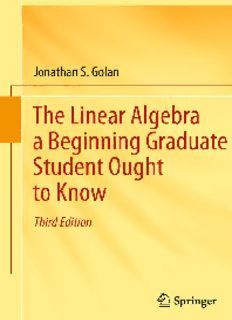Table Of ContentThe Linear Algebra a Beginning Graduate
Student Ought to Know
Jonathan S. Golan
The Linear Algebra
a Beginning Graduate
Student Ought
to Know
Third Edition
Prof.JonathanS.Golan
Dept.ofMathematics
UniversityofHaifa
Haifa
Israel
ISBN978-94-007-2635-2 e-ISBN978-94-007-2636-9
DOI10.1007/978-94-007-2636-9
SpringerDordrechtHeidelbergLondonNewYork
LibraryofCongressControlNumber:2012933373
MathematicsSubjectClassification(2010): 15-XX,16-XX,17-XX,65F30
©SpringerScience+BusinessMediaB.V.2004,2007,2012
Nopartofthisworkmaybereproduced,storedinaretrievalsystem,ortransmittedinanyformorby
anymeans,electronic,mechanical,photocopying,microfilming,recordingorotherwise,withoutwritten
permissionfromthePublisher,withtheexceptionofanymaterialsuppliedspecificallyforthepurpose
ofbeingenteredandexecutedonacomputersystem,forexclusiveusebythepurchaserofthework.
Whilstwehavemadeconsiderableeffortstocontactallholdersofcopyrightmaterialcontainedinthis
book.Wehavefailedtolocatesomeofthem.ShouldholderswishtocontactthePublisher,wewillmake
everyefforttocometosomearrangementwiththem.
Printedonacid-freepaper
SpringerispartofSpringerScience+BusinessMedia(www.springer.com)
To thememoryofHemda,mywifeofover40
years:
Andtomygrandchildren: Shachar, Eitan,
Sarel, Nachshon, Yarden, Itamar,Roni,and
Naomi
For Whom Is This Book Written?
Crow’sLaw:Donotthinkwhatyouwanttothinkuntilyouknowwhatyou
oughttoknow.1
Linearalgebraisa living,activebranchof mathematicalresearch whichis central
toalmostallotherareasofmathematicsandwhichhasimportantapplicationsinall
branchesofthephysicalandsocialsciencesandinengineering.However,inrecent
years the content of linear algebra courses required to complete an undergraduate
degreeinmathematics—andevenmoresoinotherareas—atallbutthemostded-
icated universities, has been depleted to the extent that it falls far short of what is
in fact needed for graduate study and research or for real-world application. This
is true not only in the areas of theoretical work but also in the areas of computa-
tionalmatrixtheory,whicharebecomingmoreandmoreimportanttotheworking
researcher as personal computers become a common and powerful tool. Students
arenotonlylessabletoformulateorevenfollowmathematicalproofs,theyarealso
lessabletounderstandtheunderlyingmathematicsofthenumericalalgorithmsthey
mustuse.Theresultingknowledgegaphasledtofrustrationandrecriminationon
the part of both students and faculty alike, with each silently—and sometimes not
sosilently—blamingtheotherfortheresultingstateofaffairs.Thisbookiswritten
with the intention of bridging that gap. It was designed be used in one or more of
severalpossibleways:
(1) Asaself-studyguide;
(2) Asatextbookforacourseinadvancedlinearalgebra,eitherattheupper-class
undergraduateleveloratthefirst-yeargraduatelevel;or
(3) Asareferencebook.
It is also designed to be used to prepare for the linear algebra portion of prelim
examsorPh.D.qualifyingexams.
This volume is self-contained to the extent that it does not assume any previ-
ousknowledgeofformallinearalgebra,thoughthereaderisassumedtohavebeen
exposed,atleastinformally,tosomebasicideasortechniques,suchasmatrixma-
nipulationandthesolutionofasmallsystemoflinearequations.Itdoes,however,
1Thislaw,attributedtoJohnCrowofKing’sCollege,London,isquotedbyR.V.Jonesinhisbook
MostSecretWar,Wordsworth,1998(ISBN978-1853266997).
vii
viii ForWhomIsThisBookWritten?
assumeaseriousnessofpurpose,considerablemotivation,andmodicumofmathe-
maticalsophisticationonthepartofthereader.
Thetheoreticalconstructionspresentedhereareillustratedwithalargenumberof
examplestakenfromvariousareasofpureandappliedmathematics.Asinanyarea
ofmathematics,theoryandconcreteexamplesmustgohandinhandandneedtobe
studied together. As the German philosopher Immanuel Kant famously remarked,
conceptswithoutpreceptsareempty,whereaspreceptswithoutconceptsareblind.
The book also contains a large number of exercises, many of which are quite
challenging,whichIhavecomeacrossorthoughtupinoverthirtyyearsofteaching.
Many of these exercises have appeared in print before, in such journals as Ameri-
can Mathematical Monthly, College Mathematics Journal, Mathematical Gazette,
orMathematicsMagazine,invariousmathematicscompetitionsorcirculatedprob-
lem collections, or even on the internet. Some were donated to me by colleagues
andevenstudents,andsomeoriginatedinfilesofoldexamsatvariousuniversities
whichIhavevisitedinthecourseofmycareer.Since,overtheyears,Ididnotkeep
trackoftheirsources,allIcandoisofferacollectiveacknowledgementtoallthose
towhomitisdue.Goodproblemformulators,liketheGodoftheabbotofCiteaux,
knowtheirown.Deliberately,difficultexercisesarenotmarkedwithanasteriskor
othersymbol.Solvingexercisesisanintegralpartoflearningmathematicsandthe
reader is definitely expected to do so, especially when the book is used for self-
study. Try them all and remember the “grook” penned by the Danish genius Piet
Hein:Problemsworthyofattack/Provetheirworthbyhittingback.
Solving a problem using theoretical mathematics is often very different from
solvingitcomputationally,andsostrongemphasisisplacedontheinterplayofthe-
oretical and computational results. Real-life implementation of theoretical results
isperpetuallyplaguedbyerrors: errors inmodeling,errors indataacquisitionand
recording,and errors in thecomputationalprocess itself due toroundoff andtrun-
cation. There are further constraints imposed by limitations in time and memory
availableforcomputation.Thusthemosteleganttheoreticalsolutiontoaproblem
maynotleadtothemostefficientorusefulmethodofsolutioninpractice.Whileno
referenceismadetoparticularcomputersoftware,theconcurrentuseofapersonal
computerequippedsymbolic-manipulationsoftwaresuchasMAPLE,MATHEMAT-
ICA,MATLAB,orMUPADisdefinitelyadvised.
In order to show the “human face” of mathematics, the book also includes a
largenumberofthumbnailphotographsofresearcherswhohavecontributedtothe
developmentofthematerialpresentedinthisvolume.
Acknowledgements Most of the first edition this book was written while I was
avisitorattheUniversityofIowainIowaCityandattheUniversityofCalifornia
inBerkeley.Iwouldliketothankbothinstitutionsforprovidingthefacilitiesand,
more importantly, the mathematical atmosphere which allowed me to concentrate
on writing. Subsequent, extensively revised editions, were prepared after I retired
fromteachingattheUniversityofHaifainApril,2004.
Ihavetalkedtomanystudentsandfacultymembersaboutmyplansforthisbook
and have obtained valuable insights from them. In particular, I would like to ac-
knowledgetheaidofthefollowingcolleaguesandstudentswhowerekindenough
ForWhomIsThisBookWritten? ix
toreadthepreliminaryversionsofthisbookandoffertheircommentsandcorrec-
tions: Prof. Daniel Anderson (University of Iowa), Prof. Adi Ben-Israel (Rutgers
University),Prof.RobertCacioppo(TrumanStateUniversity),Prof.JosephFelsen-
stein (University of Washington), Prof. Ryan Skip Garibaldi (Emory University),
Mr.GeorgeKirkup(UniversityofCalifornia,Berkeley),Dr.DenisSevee(JohnAl-
bert College), Prof. Earl Taft (Rutgers University), Mr. Gil Vernik (University of
Haifa).
Haifa,Israel JonathanS.Golan
Description:Linear algebra is a living, active branch of mathematics which is central to almost all other areas of mathematics, both pure and applied, as well as to computer science, to the physical, biological, and social sciences, and to engineering. It encompasses an extensive corpus of theoretical results a

